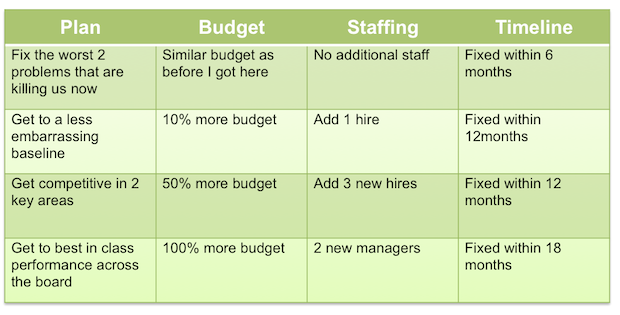The challenge: Resources are cut AND work is added
This problem has been coming up a lot recently in my coaching hour conference calls, so I wanted to share some advice here.
They way this is often stated is:
“My company has downsized, but now my team has been given the work of other teams that no longer exist. We’re expected to handle the extra work, but we were already overloaded. There is no one to take on the new work, yet management is expecting us to to get it done.”
Don’t undermine yourself with tireless work
It’s important to realize that simply taking on the unreasonable workload by asking everyone to work 24×7 is not the right approach. You need to remember that your company can absorb an unlimited amount of work from you without really noticing or caring about the impact it is having on you and your team.
If you keep everyone working around the clock and manage to get most of the work done, you are only proving that you don’t need more resources.
You need a strategy to re-define the workload and share the problem.
Here are some steps that will help you.
1. Determine if there is a new way to do the work
If, for example, you team was supporting 50 customers with 15 people, and now you are being asked to support 150 customers with 15 people, it’s clear that doing the support the same way will not work. But are there systems you could put in place to scale how you do the work? Automation, self service, better documentation, community support functionality, etc.
Your management may not be expecting you to simply do more work, but to re-invent the way the work is done.
It’s always important to think through this step and find ways to improve the process if possible.
But… if you’ve exhausted those possibilities and the workload is simply un-doable, then you need to move to the next step of changing the conversation about the work to reflect the reality.
2. Show the size of the hole you are in
Sometimes executives will assign a pile of work and have no idea what is actually involved in doing it.
If they give you an impossible workload on top of an already challenging workload, if they do not see the reality of the situation, they will expect that you can simply absorb the extra work.
To show the reality, create something that looks kind of like this chart below.
Show the actual state vs. the desired state. And if you have data about competitors it’s helpful to include it.
By showing this picture you are communicating in a credible way that there is more to be done to achieve the outcome they are asking for than they realize.
3. Share the problem
I see leaders often put all the pressure on themselves to try to do the impossible without the necessary resources, and feel like they are personally failing when it can’t be done.
This is not your problem alone.
This is a choice that the company needs to make.
Your job is to shine the spotlight on clearly defined choices.
The idea you need to communicate is that this un-doable workload is putting the business at risk. “WE need to collectively decide what we are willing to tolerate in terms of deliverables and risk, and agree on a set of doable outcomes and priorities”.
The way to do this is to provide choices and options.
4. Show the true cost of options..
You need to give the management choices for different levels of outcomes that have different levels of cost.
Create a chart that shows different levels of investment with their associated outcomes. Then engage your executives in choosing the level. If they choose a low funding level, they will get the amount of work that’s possible at that level.
OK, if you don’t increase my budget, we can add one item, but we can’t add most of the competitive features. If that’s the funding choice you make, this is what you will get.
If they want great, complete, best in class work, or very low risk, they can get that only with a higher level of funding.
The chart looks something like this:
Don’t set yourself up for failure. Don’t accept the line of reasoning that you are just supposed to be able to absorb an unlimited amount of extra work with the same number of people, and keep delivering at the same level and scope of quality, excellence and completeness.
If you show the reality and share the problem, you are still building credibility by showing that you can do the complete job, but you are not shooting yourself in the foot by signing up to do it without enough resources.
If you are facing this issue, you are not alone. This is a very common leadership challenge, and it’s up to you to navigate it in such a way that you can create success for the business without killing yourself and your team in the process!
I talk more about this in chapter 5 of my book MOVE: Resource Reality. That chapter ends with, “What if you show them all the choices and they don’t give you the extra money, and tell you to do it anyway?”. That leads to Chapter 6: Don’t sign up for the impossible.
You can get your copy of MOVE or download a preview:
What do you think?
Join the conversation about this on my facebook page.
Was this useful?
If you found this article useful, please help me share it with others and encourage them to subscribe to this Blog for free.
Patty Azzarello is an executive, best-selling author, speaker and CEO/Business Advisor. She became the youngest general manager at HP at the age of 33, ran a billion dollar software business at 35 and became a CEO for the first time at 38 (all without turning into a self-centered, miserable jerk)
You can find Patty at www.AzzarelloGroup.com, follow her on twitter or facebook






